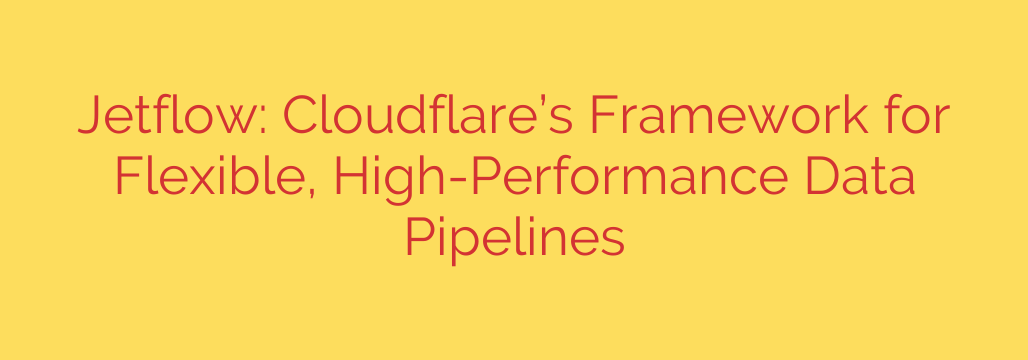
Next-Generation Data Pipelines: A Framework for Unprecedented Scale and Flexibility
In today’s digital landscape, the flow of data is relentless. From user interactions and application logs to security events and performance metrics, organizations are inundated with information. Processing this data in real-time is no longer a luxury but a necessity for making informed decisions, identifying threats, and delivering a seamless user experience. However, traditional data processing pipelines often struggle to keep up, burdened by complexity, high costs, and operational overhead.
A modern, unified framework for stream processing is emerging to solve these challenges. This new approach is designed from the ground up to handle data at a global scale, offering a level of performance and flexibility that legacy systems can’t match. Let’s explore the architecture behind this powerful technology and what it means for the future of data engineering.
The Challenge with Traditional Data Streaming
For years, building a data pipeline meant stitching together multiple complex systems. Engineers often relied on a combination of tools like Kafka for message queuing, Flink or Spark for stream processing, and various databases or storage solutions for the final output. While powerful, this approach creates significant challenges:
- High Operational Complexity: Managing, scaling, and ensuring the reliability of these disparate systems requires specialized expertise and constant maintenance.
- Cost Inefficiency: Running and scaling multiple services can lead to spiraling infrastructure costs.
- Lack of Unification: Different teams often build their own pipelines for different needs, leading to siloed, inconsistent, and duplicated efforts across an organization.
These issues become magnified when operating on a global scale, where data must be processed reliably across dozens or even hundreds of data centers.
A New Architecture for High-Performance Data Processing
To overcome these limitations, a new type of framework has been developed, built on the principles of simplicity, unification, and extreme performance. At its core, this architecture defines a data pipeline as a Directed Acyclic Graph (DAG), which is a clear, structured way to represent the flow of data from start to finish.
Every pipeline built within this framework consists of three fundamental components:
- Sources: These are the entry points for your data. A source could be anything from an HTTP endpoint receiving logs, a message queue, or a system that reads from object storage. It’s where the data journey begins.
- Sinks: These are the destinations for your processed data. After passing through the pipeline, data might be sent to a data warehouse for analytics, a monitoring service for alerting, or long-term cold storage.
- Processors: This is where the magic happens. Processors are nodes within the pipeline that transform, enrich, filter, or aggregate the data as it flows through. They can perform simple, stateless operations (like filtering out specific fields) or complex, stateful calculations (like counting unique users over a five-minute window).
By combining these three building blocks, engineers can rapidly construct and deploy sophisticated data pipelines for a vast array of applications without managing the underlying infrastructure.
Key Advantages of a Modernized Framework
This unified approach delivers several game-changing benefits that are critical for modern data operations and security.
Unmatched Performance and Scalability
Designed to run on a globally distributed network, this type of framework can process trillions of messages per day without breaking a sweat. Its architecture is built for horizontal scaling, ensuring that as data volume grows, the system can expand its capacity seamlessly to meet demand.
Guaranteed Data Integrity with “Exactly-Once” Processing
In critical applications like billing or security analytics, losing or duplicating data is unacceptable. This framework provides exactly-once processing semantics, a powerful guarantee that every message is processed once and only once, even in the event of system failures. This built-in resilience ensures that your data is always accurate and reliable.
True Flexibility for Diverse Use Cases
A single, unified framework can power a wide range of critical functions. For example:
- Centralized Logging: Aggregate logs from all services into one pipeline for streamlined analysis and troubleshooting.
- Real-Time Analytics: Power live dashboards that track key business metrics or product usage.
- Security Monitoring: Analyze security events in real-time to detect threats, identify anomalies, and block malicious activity before it can cause damage.
Reduced Operational Overhead and Cost
By abstracting away the complexity of managing message queues and processing clusters, this framework allows engineering teams to focus on building value, not maintaining infrastructure. This leads to faster development cycles, lower operational costs, and improved overall efficiency.
Actionable Security Insights
For security teams, a high-performance data pipeline is an indispensable tool. When you can process security logs and event data in real-time at scale, you unlock powerful capabilities:
- Proactive Threat Detection: Instead of discovering a breach weeks after it happened, you can identify suspicious patterns as they emerge. A pipeline can analyze login attempts, API calls, and network traffic to flag potential attacks in real-time.
- Automated Response: Connect your pipeline to security tools to automate responses. For example, if the pipeline detects a DDoS attack, it can automatically trigger mitigation rules.
- Comprehensive Auditing: Ensure all relevant security data is reliably captured, processed, and archived for compliance and forensic analysis.
The Future is Unified and Scalable
The era of complex, brittle, and expensive data pipelines is coming to an end. Modern, unified frameworks demonstrate that it’s possible to achieve flexibility, reliability, and massive scale without the associated operational pain. By embracing this new model, organizations can unlock the full potential of their data, enabling faster innovation, smarter decisions, and a more secure digital environment.
Source: https://blog.cloudflare.com/building-jetflow-a-framework-for-flexible-performant-data-pipelines-at-cloudflare/








